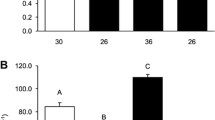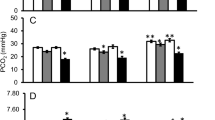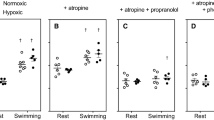Abstract
Environmental conditions play a major role in shaping reptilian embryonic development, but studies addressing the impact of interactions between chronic and acute environmental stressors on embryonic systems are lacking. In the present study, we investigated thermal dependence of cholinergic and adrenergic cardiovascular tone in embryonic American alligators (Alligator mississippiensis) and assessed possible phenotypic plasticity in a chronic hypoxic incubation treatment. We compared changes in heart rate (f H) and mean arterial blood pressure (P M) for chronically hypoxic and normoxic-incubated embryos after cholinergic and adrenergic blockade following three different acute temperature treatments: (1) 30 °C (control incubation temperature), (2) acute, progressive decrease 30–24 °C then held at 24 °C, and (3) acute, progressive increase 30–36 °C then held at 36 °C. f H progressively fell in response to decreasing temperature and rose in response to increasing temperature. P M did not significantly change with decreasing temperature, but was lowered significantly with increasing acute temperature in the normoxic group at 90 % of development only. Propranolol administration (β adrenergic antagonist) produced a significant f H decrease at 24, 30, and 36 °C that was similar at all temperatures for all groups. For normoxic-incubated embryos at 90 % of development, atropine administration (cholinergic antagonist) significantly increased f H in both 24 and 36 °C treatments, but not in the 30 °C control treatment. This atropine response at 24 and 36 °C demonstrated acute thermally dependent cholinergic tone on f H late in development for normoxic-incubated, but not chronically hypoxic-incubated embryos. Collectively, data indicated that cardiovascular control mechanisms in embryonic alligators may be activated by thermal extremes, and the maturation of control mechanisms was delayed by chronic hypoxia.





Similar content being viewed by others
Abbreviations
- CAM:
-
Chorioallantoic membrane
- f H :
-
Heart rate
- P M :
-
Mean arterial pressure
- T E :
-
Temperature of embryo, from thermocouple probe inserted into allantoic fluid
- N70 or N90:
-
Alligator embryos incubated in chronic normoxia, measured at 70 or 90 % of embryonic development, respectively
- H70 or H90:
-
Alligator embryos incubated in chronic hypoxia (10 % O2) beginning at 20 % of development, measured at 70 or 90 % of embryonic development, respectively
References
Ackerman RA (1980) Physiological and ecological aspects of gas exchange by sea turtle eggs. Am Zool 20:575–583
Ackerman RA (1981) Growth and gas exchange of embryonic sea turtles (Chelonia caretta). Copeia 1981:757–765
Altimiras J, Axelsson M (2004) Intrinsic autoregulation of cardiac output in rainbow trout (Oncorhynchus mykiss) at different heart rates. J Exp Biol 207:195–201
Birchard GF (2000) An ontogenetic shift in the response of heart rates to temperature in the developing snapping turtle (Chelydra serpentina). J Therm Biol 25:287–291
Birchard GF, Reiber CL (1996) Heart rate during development in the turtle embryo: effect of temperature. J Comp Physiol B 166:461–466
Booth DT (2000) The effect of hypoxia on oxygen consumption of embryonic estuarine crocodiles (Crocodylus porosus). J Herpetol 34:478–481
Boyer DR (1967) Interaction of temperature and hypoxia on respiratory and cardiac responses in the lizard, Sauromalus obesus. Comp Biochem Physiol 20:437–447
Branco LG, Portner HO, Wood SC (1993) Interaction between temperature and hypoxia in the alligator. Am J Physiol Reg Integ Comp 265:R1339–R1343
Burger J (1990) Effects of incubation temperature on behavior of young black racers (Coluber constrictor) and kingsnakes (Lampropeltis getulus). J Herpetol 24:158–163
Burggren WW, Keller BB (1997) Development of cardiovascular systems: molecules to organisms. In: Burggren WW, Keller BB (eds) Cambridge University Press, Cambridge, UK, pp 360
Burggren WW, Reyna KS (2011) Developmental trajectories, critical windows and phenotypic alteration during cardio-respiratory development. Respir Physiol Neurobiol 178:13–21
Chabreck RH (1973) Temperature variation in nests of the American alligator. Herpetologica 29:48–51
Clark TD, Butler PJ, Frappell PB (2005) Digestive state influences the heart rate hysteresis and rates of heat exchange in the varanid lizard Varanus rosenbergi. J Exp Biol 208:2269–2276
Coulson RA, Hernandez T (1983) Alligator metabolism. Studies on chemical reactions in vivo. Comp Biochem Physiol B 741:1–182
Courtice GP (1990) Effect of temperature on cardiac vagal action in the toad (Bufo marinus). J Exp Biol 149:439–447
Crossley DA II, Altimiras J (2005) Cardiovascular development in embryos of the American alligator Alligator mississippiensis: effects of chronic and acute hypoxia. J Exp Biol 208:31–39
Crossley DA II, Hicks JW, Altimiras J (2003) Ontogeny of baroreflex control in the American alligator Alligator mississippiensis. J Exp Biol 206:2895–2902
Du WG, Thompson MB, Shine R (2010a) Facultative cardiac responses to regional hypoxia in lizard embryos. Comp Biochem Physiol A 156:491–494
Du WG, Ye H, Zhao B, Warner DA, Shine R (2010b) Thermal acclimation of heart rates in reptilian embryos. PLoS One 5:e15308
Elphick MJ, Shine R (1998) Longterm effects of incubation temperatures on the morphology and locomotor performance of hatchling lizards (Bassiana duperreyi, Scincidae). Biol J Linn Soc 63:429–447
Eme J, Altimiras J, Hicks JW, Crossley DA II (2011a) Hypoxic alligator embryos: chronic hypoxia, catecholamine levels and autonomic responses of in ovo alligators. Comp Biochem Physiol A 160:412–420
Eme J, Hicks JW, Crossley DA II (2011b) Chronic hypoxic incubation blunts a cardiovascular reflex loop in embryonic American alligator (Alligator mississippiensis). J Comp Physiol B 181:981–990
Ferguson MWJ (1985) Reproductive biology and embryology of the crocodilians. In: Gans C, Billet F, Maderson P (eds) Biology of the reptilia, 14A edn. Wiley, New York, pp 329–349
Gamperl KA, Swafford BL, Rodnick KJ (2011) Elevated temperature, per se, does not limit the ability of rainbow trout to increase stroke volume. J Therm Biol 36:7–14
Gasser HS (1931) Nerve activity as modified by temperature changes. Am J Physiol 97:254–276
Glass ML, Hicks JW, Riedesel ML (1979) Respiratory responses to long-term temperature exposure in the box turtle, Terrapene ornata. J Comp Physiol B 131:353–359
Gutzke WHN, Packard GC (1987) Influence of the hydric and thermal environments on eggs and hatchlings of bull snakes (Pituophis melanoleucus). Physiol Zool 60:9–17
Hicks JW, Wood SC (1985) Temperature regulation in lizards: effects of hypoxia. Am J Physiol Regul Integr Comp 248:R595–R600
Jackson DC (1973) Ventilatory response to hypoxia in turtles at various temperatures. Respir Physiol 18:178–187
Janzen FJ (1993) The influences of incubation temperature and family on eggs, embryos, and hatchlings of the smooth softshell turtle (Apalone mutica). Physiol Zool 66:349–373
Joanen T (1969) Nesting ecology of alligators in Louisiana. In: Proceedings of the annual conference Southeast association game and fish communication 24:141–151
Kalman JM, Tonkin AM, Power JM (1995) Specific effects of zatebradine on sinus node function: suppression of automaticity, prolongation of sinoatrial conduction and pacemaker shift in the denervated canine heart. J Pharmacol Exp Ther 272:85–93
Kam YC (1993) Physiological effects of hypoxia on metabolism and growth of turtle embryos. Respir Physiol 92:127–138
Lutz PL, Dunbar-Cooper A (1984) The nest environment of the American crocodile (Crocodylus acutus). Copeia 1:153–161
McIlhenny EA (1934) Notes on incubation and growth of alligators. Copeia 1934:80–88
Miller SC, Gillis TE, Wright PA (2011) The ontogeny of regulatory control of the rainbow trout (Oncorhynchus mykiss) heart and how this is influenced by chronic hypoxia exposure. J Exp Biol 214:2065–2072
Nakahara T, Kawada T, Sugimachi M, Miyano H, Sato T, Shishido T, Yoshimura R et al (1998) Cholinesterase affects dynamic transduction properties from vagal stimulation to heart rate. Am J Physiol Regul Integr Comp 275:R541–R547
Nechaeva MV (2011) Physiological responses to acute changes in temperature and oxygenation in bird and reptile embryos. Respir Physiol Neurobiol 178:108–117
Nechaeva MV, Makarenko IG, Tsitrin EB, Zhdanova NP (2005) Physiological and morphological characteristics of the rhythmic contractions of the amnion in veiled chameleon (Chamaeleo calyptratus) embryogenesis. Comp Biochem Physiol A 140:19–28
Nechaeva MV, Vladimirova IG, Alekseeva TA (2007) Oxygen consumption as related to the development of the extraembryonic membranes and cardiovascular system in the European pond turtle (Emys orbicularis) embryogenesis. Comp Biochem Physiol A 148:599–606
Nielsen B (1962) On the regulation of respiration in reptiles II. The effect of hypoxia with and without moderate hypercapnia on the respiration and metabolism of lizards. J Exp Biol 39:107–117
Oppenheim RW, Levin HL (1975) Short-term changes in incubation temperature: behavioral and physiological effects in the chick embryo from 6 to 20 days. Dev Psychobiol 8:103–115
Petersen AM, Gleeson TT, Scholnick DA (2003) The effect of oxygen and adenosine on lizard thermoregulation. Physiol Biochem Zool 76:339–347
Pockett S, Macdonald JA (1986) Temperature dependence of neurotransmitter release in the Antarctic fish (Pagothenia borchgrevinki). Experientia 42:414–415
Priede IG (1974) The effect of swimming activity and section of the vagus nerves on heart rate in rainbow trout. J Exp Biol 60:305–319
Seebacher F (2000) Heat transfer in a microvascular network: the effect of heart rate on heating and cooling in reptiles (Pogona barbata and Varanus varius). J Theor Biol 203:97–109
Seebacher F, Franklin CE (2003) Prostaglandins are important in thermoregulation of a reptile (Pogona vitticeps). Proc Biol Sci 270:S50–S53
Seebacher F, Franklin CE (2004) Integration of autonomic and local mechanisms in regulating cardiovascular responses to heating and cooling in a reptile (Crocodylus porosus). J Comp Physiol B 174:577–585
Seebacher F, Franklin CE (2005) Physiological mechanisms of thermoregulation in reptiles: a review. J Comp Physiol B 175:533–541
Seibert H (1979) Thermal adaptation of heart rate and its parasympathetic control in the European eel Anguilla anguilla (L.). Comp Biochem Physiol C 64:275–278
Snyder GK, Black CP, Birchard GF (1982) Development and metabolism during hypoxia in embryos of high altitude Anser indicus versus sea level Branta canadensis geese. Physiol Zool 55:113–123
Sureau D, Lagardere JP, Pennec JP (1989) Heart rate and its cholinergic control in the sole (Solea vulgaris), acclimatized to different temperatures. Comp Biochem Physiol A 92:49–51
Takeuchi N (1958) The effect of temperature on the neuromuscular junction of the frog. Jpn J Physiol 8:391–404
Tate KB, Eme J, Swart J, Conlon JM, Crossley DA II (2012) Effects of dehydration on cardiovascular development in the embryonic American alligator (Alligator mississippiensis). Comp Biochem Physiol A 162:252–258
Taylor EW, Ihmied YM (1995) Vagal and adrenergic tone on the heart of Xenopus laevis at different temperatures. J Therm Biol 20:55–59
Taylor EW, Short S, Butler PJ (1977) The role of the cardiac vagus in the response of the dogfish (Scyliorhinus canicula) to hypoxia. J Exp Biol 70:57–75
Wood CM, Pieprzak P, Trott JN (1979) The influence of temperature and anaemia on the adrenergic and cholinergic mechanisms controlling heart rate in the rainbow trout. Can J Zool 57:2440–2447
Wood SC, Hicks JW, Dupré RK (1987) Hypoxic reptilians: blood gases, body temperature, and control of breathing. Am Zool 27:21–29
Acknowledgments
Our work would not have been possible without help from Phillip “Scooter” Trosclair III and Dwayne LeJeune. We thank Kevin Tate and Zachary Kohl for assistance with embryo care and data collection. The National Science Foundation CAREER award IBN IOS-0845741 to DAC supported this work.
Author information
Authors and Affiliations
Corresponding author
Additional information
Communicated by H.V. Carey.
Rights and permissions
About this article
Cite this article
Marks, C., Eme, J., Elsey, R.M. et al. Chronic hypoxic incubation blunts thermally dependent cholinergic tone on the cardiovascular system in embryonic American alligator (Alligator mississippiensis). J Comp Physiol B 183, 947–957 (2013). https://doi.org/10.1007/s00360-013-0755-2
Received:
Revised:
Accepted:
Published:
Issue Date:
DOI: https://doi.org/10.1007/s00360-013-0755-2




